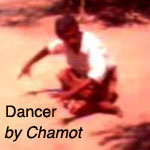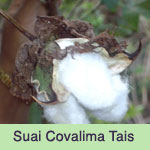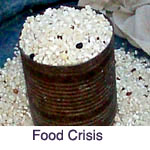Tetun version: Uma Lulik Tradisional Lakon Kalae?
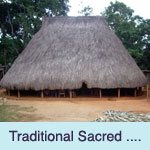 See More Photographs here.
See More Photographs here.
This is the traditional sacred house of Timor, particularly in Covalima. The traditional sacred houses still exist. Our ancestors have passed on to us these traditional sacred houses from one generation to another. Traditional sacred house is very, very sacred. Therefore, whenever we are in the traditional sacred house, it is forbidden to talk, to chat and to put on hat. In addition, the elders are to be respected. People have to follow their words of wisdom. If not, then the punishment from the Above, the High in sky, would descend on you taking the forms of: death, being barren/having no children, becoming mad, or becoming confused and restless. Therefore, we Timorese really adore and respect our traditional sacred houses and our elders.
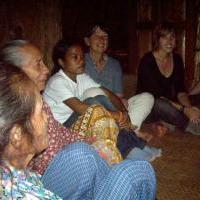
Sitting together in a sacred house
“Sitting Together”
The process of building a traditional house needs a very long time. It involves many meetings, working together and traditional ceremonies.
The community members have to sit together. All the members who belong to one sacred house or uma lulik get together to make plan for the construction of the uma lulik. This includes those who married to people of other tribes and to the non-Timorese—the white and non-white foreigners—but who have not abandoned, and should not abandon, their traditional practices. All members of the sacred house (community) get together to make preparation for the building and the completion of the sacred house which ends with a very big celebration that lasts several days, in the past, even weeks. During this celebration of uma lulik people from other communities are invited. Preparation for the celebration of the completion and the blessing (traditional blessing) of the sacred house involve the preparations of buffaloes, pigs, goats, rice, local alcohol, tais, cova (traditional male and female baskets called cova mane and cova feto) and others for the celebrations.
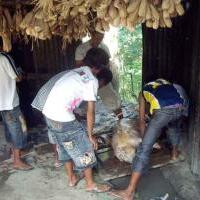
“Ceremony of slaughtering of pigs as an offering”
When the two main pillars for the sacred house have been found suitable, a small religious ceremony is conducted before the cutting of the trees for the pillars. A pig is slaughtered and the blood of the pig is sprinkled at the bottom of the trees and a prayer is said, led by an elder, before the trees are cut down. After that an offering of cooked heart of the pig and cooked rice, along with beetle nuts and beetle leaves are offered at the bottom of the trees. This is a sign of respect for the trees and a way of asking permission from the spiritual owners of the trees (the spirits of the land/the forest which is seen as being sacred).
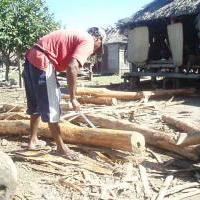
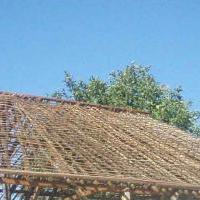
“Cutting trees for the pillars”or“Putting the ‘bones’ of house.”
The two main pillars are named after the names of the Grandfather and Grandmother of the sacred house community. The Grandfather is the south pillar which becomes the place in the house for sacred adoration, prayers and offerings, for the elder of the use to bless the members of the sacred house by means of what is called kaba. The ceremony of kaba is as follows. The offering in the form of beetle nuts and beetle leaves putting in a specially made female koba/cova (small and beautifully made basket) is made to the ancestors and is put on the bottom of the Grandfather’s pillar. After a prayer was said by the elder, the beetle nuts and beetle leaves are eaten by the elders but not swallowed. The elder then makes a mark on the chests and foreheads of the members of community with the crushed beetle nuts and leaves from his mouth mixed with saliva. And this is called kaba. The female pillar with the name of the grandmother is on the north where the kitchen is. It is just referred to is grandmother or bei feto. It is here in this side of the female pillar—the grandmother—that sacred baskets, sacred pots, sacred spoons and plate, sacred inheritance and others are kept.
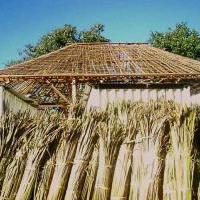
Collecting ropes/strings and leaves together and putting the bones of house.
Collecting together grass/palm leaves
Having putting together the bones (woods) of the house tied tightly with strings from the forest, the roof of the house is put. The roof consists of either certain type of grass called hae manu lain for the people in highland where there are no palm tress or the leaves of the palm trees for the people in the coastal area and lowland. All these are done together in the group.
Having putting together the bones (woods) of the house tied tightly with strings from the forest, the roof of the house is put. The roof consists of either certain type of grass called hae manu lain for the people in highland where there are no palm tress or the leaves of the palm trees for the people in the coastal area and lowland. All these are done together in the group.
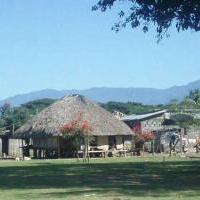
The Result of the process of building sacred house
The result of the process of constructing a sacred house is as follows. All the members of the uma lulik (the community) are very happy, although the process of building a sacred house is very long—a one-year-long process.
